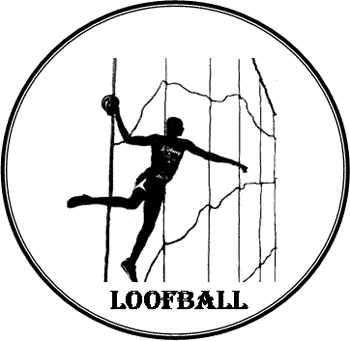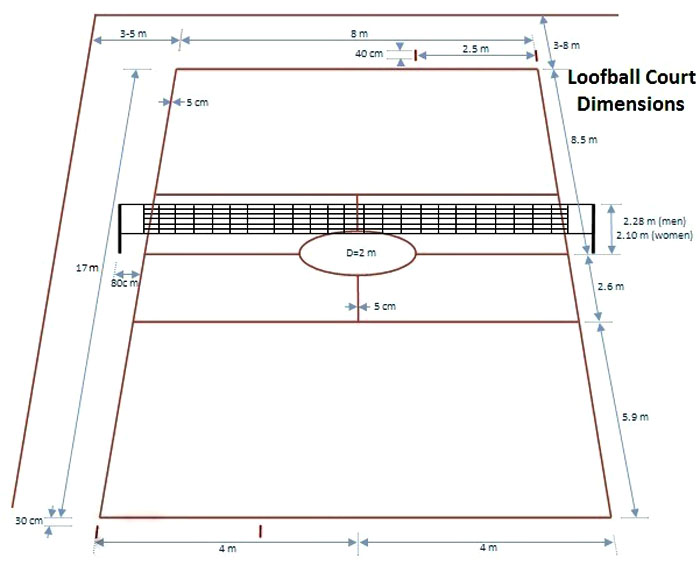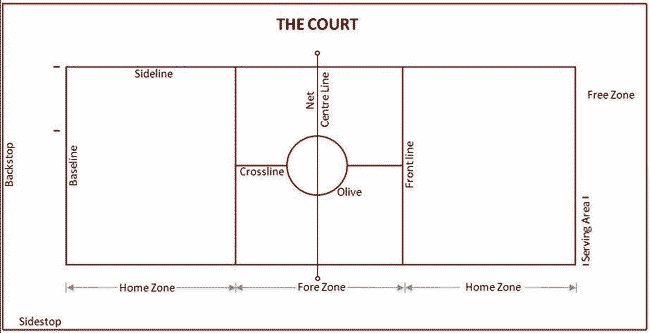Loofball is a relatively new sport, created by Winner Vidiyeno Matahula from Nigeria in 2017. Loofball is a non-contact sport played on a distinctive rectangular court in which two teams of five players each compete by throwing of a specially designed hairy ball (also called Loofball) over the net, with intent to down the ball in the opposition half subject to set rules and regulations.
The sport is played either indoor or outdoor, and combines some elements of Volleyball and Handball. It is a 'catch-and-throw' type of sport in which only the hand and forearm are allowed to touch the ball.
OBJECT OF THE GAME
The object of loofball is to launch the ball over the net such that it lands on the appropriate zone or section of the court, and prevent the same effort by the opposition. A play (or combat) begins with a serve by launching the ball over the net and into the opposition's home zone. A team scores a point when the ball lands on the appropriate zone or section of the opposition's court, or when the opposition fails to return the ball by committing a fault.
The basic skills required in the game are the ability to defend or catch the ball firmly with the hands and the ability to launch it over the net during combat or service. A game plan regarding positioning, movement and tricks is also of great importance for a team to win a combat.
A match is played for best two out of three sets. In other words, a match is won by the first team to win two sets. The first two sets are played for 25 points whereas the third set is played for 20 points. Each set must be won with a 2 point advantage. 
PHILOSOPHY OF THE GAME
Loofball is an exciting, recreational and competitive sport created against the backdrop of the societal ills and violence happening in the 21st century to promote peace and peaceful coexistence, through active participation of youths in sports and sports development. Our goal is to propagate the game of Loofball from the grass roots to national and international levels, as we seek to develop and establish a fun sports activity that will advance the cause of peace and promote growth and development.
The physiological, social and moral objectives of the game include;
- To achieve physical fitness, body strength and overall wellness.
- To encourage discipline, respect, fair play and good sportsmanship.
- To foster team spirit, unity and togetherness.
- To enhance positivity and resilience among players.
Loofball also offers numerous mental and emotional benefits, and is suitable for children, adults and old folk alike. The unique and dynamic nature of the game renders it one of the most attractive and promising games in emerging contemporary sports.
BASIC GAME RULES
Team Members: There are five players per team.
Ball Contact:
- Contact with the ball is strictly by the hand or forearm. In other words, the ball must not touch a part of the body other than the hand and forearm.
- A player makes no more than two steps with the ball
- A player does not hold or throw the ball more than once within a game turn.
- Minimum of two and maximum of three throws in a turn. A throw may be a 'hand pass', a 'forearm pass', a 'fist pass' or a shot.
- Double-catching' is allowed whereas 'multi-catching' is not allowed.
- A player does not hold the ball for more than 3 seconds.
- Only one player is allowed to catch or hold the ball at a time.
Positioning:
- Before service, players align themselves (within the home zone) in rows: three players in the front and two at the back.
- Players may change or switch positions during alignment.
- Switching positions during play is not allowed.
Service:
- During service, a left back row player throws the ball (from the serving area) into the opposition's home zone. A serve that fails to pass over the net, or results in a 'net ball', or is deemed a 'high ball' by the referee constitutes a foul serve, and must be retaken by the same player. Serving from inside the home zone, or not within 3 seconds of the referee's whistle also constitutes a foul serve. A succession of two foul serves is a scoring by the opposite team.
- In a set, the winner of a combat gets served for the next combat.
In Ball:
- When a serve, 'home shot' or 'fore shot' lands on the opposition's home zone, it said to be an 'in ball'. A 'fore shot' is also 'in' when it lands on the diagonally opposite section of the fore zone. An 'in ball' is a scoring by the sending team.
- A 'line ball' is an 'in ball' (not applicable to the olive).
Out Ball:
When a serve or 'home shot' lands on a part of the court other than the opposition's home zone, it is said to be an 'out ball'. A 'fore shot' is also 'out' when it lands on a part of the court other than the opposition's home zone and the diagonally opposite section of the fore zone. An 'out ball' is a scoring by the receiving team.
Launching The Ball:
- A shot or serve is launched strictly by throwing the ball over the net.
- A shot or serve is launched with one hand.
- A shot must be launched from inside the home zone or fore zone.
- A player does not touch or overreach the net when launching a shot.
- A 'high ball' constitutes an error during attack and a foul serve during service.
- A 'net ball' is allowed during combat whereas blocking is not allowed.
Movement:
- A player may jump when catching the ball.
- A player within the home zone may jump when launching a shot. However, both feet must have contact with the ground when launching from the fore zone.
- A player may land in the fore zone or olive after releasing a 'home shot'.
- A player may move to the olive or free zone when defending or catching a pass.
- A player stepping on the sideline or baseline is in the free zone. In the same vein, a player stepping on the frontline is in the fore zone.
- A player stepping on the crossline or both sections of the fore zone is in neither of the sections.
- A player stepping on the olive or its edge is outside the fore zone.
ERRORS/FAULTS
Any error or fault committed is a scoring by the other team. The most possible and recognized faults are as follows;
- The ball touches a part of the body other than the hand and forearm
- A serve or 'home shot' lands on a part of the court other than the opposition's home zone
- A 'fore shot' lands on a part of the court other than the opposition's home zone and the diagonally opposite section of the fore zone
- A player holds or throws the ball more than once within a turn
- A player holds the ball for up to 4 seconds (or more) during combat
- A player hits the ball when serving or launching a shot
- Less than 2 or more than 3 throws within a turn
- A player makes more than two steps with the ball
- A player launches a shot from the olive or free zone
- A player plays a 'high ball' when attacking
- A player makes 2 consecutive foul serves
- A player touches or overreaches the net when attacking
- A player serves or attacks with two hands
- Two or more players hold the ball simultaneously
- A player mishandles the ball
- A player blocks the ball
- A player jumps when launching from the fore zone
- Players switch positions during combat
GAMEPLAY
Officiating: The officiating crew may comprise a referee (also called the umpire), two or four line judges, a scorer and an assistant scorer.
Coin Toss: At the start of a match, the teams represented by their captains take part in a coin toss. The winner of the toss chooses either a side of the court or the first serve. If the winner chooses a side, the other team makes the first serve. And if the winner chooses to make the first serve, the other team chooses a side.
Scoring System: Loofball uses a point scoring system, whereby a point is awarded to the team winning a combat. A match may be played in 2 or 3 sets. The first two sets are played for 25 points, while the third set is played for 20 points. At 24 all, the team that gains a 2 point lead first, wins the set. The same applies in the third set when the scoreline is 19 all. The first team to win 2 sets carries the match.
Change of Sides: Teams change sides after completing the first set. The first team to be served in the first set makes the first serve in the second set. A new coin toss is conducted when a match enters the third set, just like in the beginning of the match.
Substitution: A maximum of four substitutions (per team) are allowed in a match. Substitution is conducted at the sideline near the fore zone.
Break: 1 minute time-out (per team) is allowed in a set. A 2 minute interval is also allowed between sets.

GAME TERMINOLOGY
- Align: Players align when they arrange themselves (within the home zone) in rows: three players in the front and two at the back, before a serve is launched.
- Combat: A sequence of attacks between serving and scoring.
- Court: An area where loofball is played. Also refers to one half of the court where a team plays from.
- Double-catch: To handle the ball twice in quick succession, or the result of such.
- Dove: A shot that results in a scoring.
- Down: To cause the ball to land by throwing it with such speed and direction.
- Fist Pass: A pass made by hitting the ball with the fist.
- Fore Shot: A shot launched from the fore zone.
- Forearm Pass: A pass made by hitting the ball with the forearm.
- Foul Serve: A serve not properly launched.
- Game Turn: The time a ball lasts on one half of the court before it is returned to the other half.
- Hand Pass: A pass made by throwing or hitting the ball with the hand.
- High Ball: A serve or shot that is more than 5 meters above the net.
- Home Shot: A shot launched from the home zone.
- Interval: The time between sets.
- Line Ball: A shot or serve that lands on the boundary line of a targeted zone or section.
- Loofballer: One who plays loofball.
- Mishandle: To commit a fault while catching or holding the ball, such that it does or doesn't result in a touchdown.
- Multi-catch: To handle the ball more than twice in quick succession, or the result of such.
- Net Ball: A serve or shot results in a 'net ball' when it touches or hits the net such that it changes speed or direction afterwards.
- Overreach: A player overreaches the net when his or her hand touches, crosses or goes beyond the net when launching the ball; a forbidden act in loofball.
- Serve: To put the ball in play, or the result of such. Also refers to a ball launched during service.
- Shot: A ball launched over the net during combat.
- Time-out: A short break allowed for consultation and rest.
- Touchdown: Happens when the ball touches the ground during play. A touchdown or fault marks the end of a combat.
- Withhold: To hold the ball for more than 3 seconds during combat, or after the referee's whistle during service.
Equipment Required
THE BALL
The game is played with a specially designed inflatable and hairy ball, also called loofball. The ball is made up of two components; an inner inflatable and an outer hairy surface. The surface may be made of a hairy fabric or animal skin (i.e. the fur) and must be homogeneous materially, uniform in design and color or combination of colors.
The ball is made in two standard sizes namely; size1 and size 2. Size 1 or mini loofball weighs 150-190 g, and has a circumference of 50.3-53.4 cm and diameter of 16-17 cm. Size 2 loofball, on the other hand, has a circumference of 59.7-62.8 cm, diameter of 19-20 cm and a weight of between 190 and 240g. A single strand on the surface does not exceed 2.5 cm in length, and the ball must be inflated to the required hardness before use.
THE NET
A basic requirement is the net, a mesh stretched at the centre of the court over which teams exchange the ball. Like in tennis or volleyball, the net is fastened to the two posts at the opposite sidelines, with its upper edge (at the centre) 2.28 m (for men) or 2.10 m (for women) above the Olive. The net should be of a white or black color and must be at least 1 m in width and 8.5 m long with mesh of uniform sizes (say 10 cm x 10 cm). The posts must be 2.15 to 2.45 m tall and 3 to 6 inches in diameter (or square).

THE FIELD
Loofball may be played on a standard loofball court, on grass or sand. The field or court measures 17 m x 8 m. The scoring area comprises two zones namely; the Home Zone and the Fore Zone. The Home Zone and Fore Zone have dimensions of 5.9 m x 8 m and 5.2 m x 8 m respectively. The Fore Zone is divided into four equal sections with two sections on either side of the net or centre line. The Olive (A circular or wreathlike region of 2 m diameter) is drawn at the middle of the court or Fore Zone.
The playing surface must be horizontal, flat, uniform and clear of any solid and sharp objects capable of causing hazard or injury to the players. Moreover, a match must not be played on a rough or slippery surface.
DRESS
All teammates must wear uniform jerseys which are distinct in color and design from those of the opponents, and numbered in the range of 11 to 25. A player's number must be on both the front and back of the jersey. Names shall be placed only on the back of the jersey above the number. Track suits or vests may be worn in cold or hot weather respectively, provided they are of the same color and design for the entire team.
Other recommended players' equipment includes sneaker footwear, fabric gloves, socks and arm band (for game captains only).
link: video
Rate this Sport
What do you think about this 'sport'? Please rate it on its potential.
Note
Related Pages
- Other New Sports
- Complete list of unusual sports
- Sport in Nigeria
Disclaimer


 Current Events
Current Events